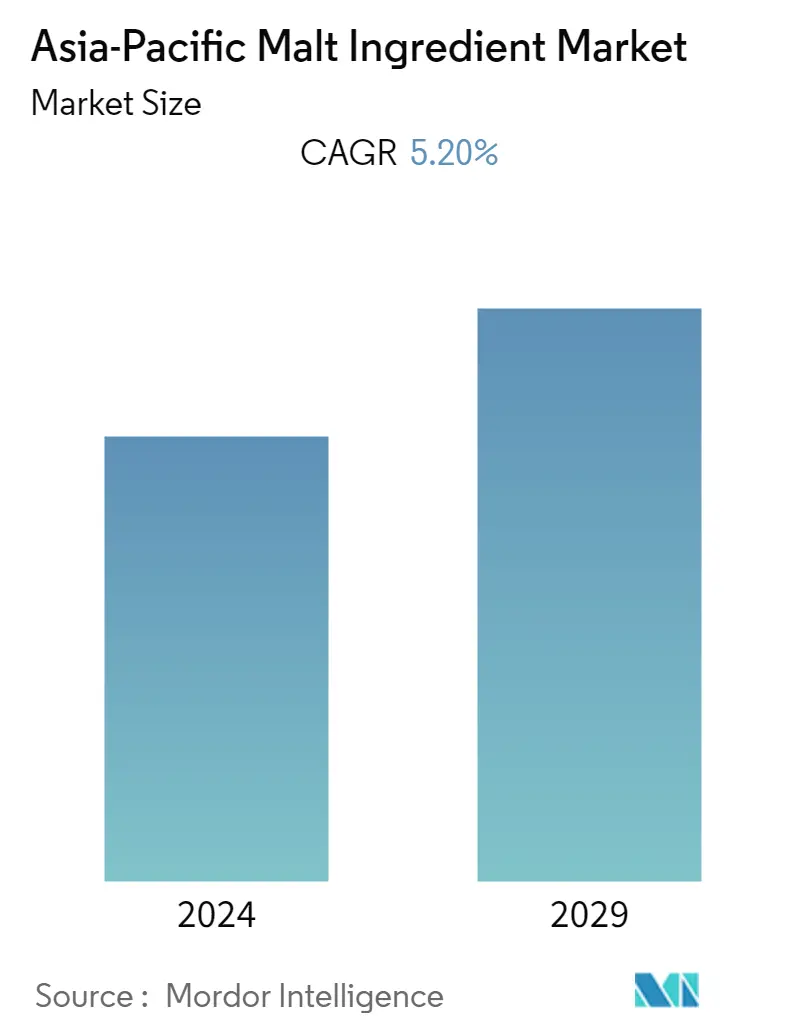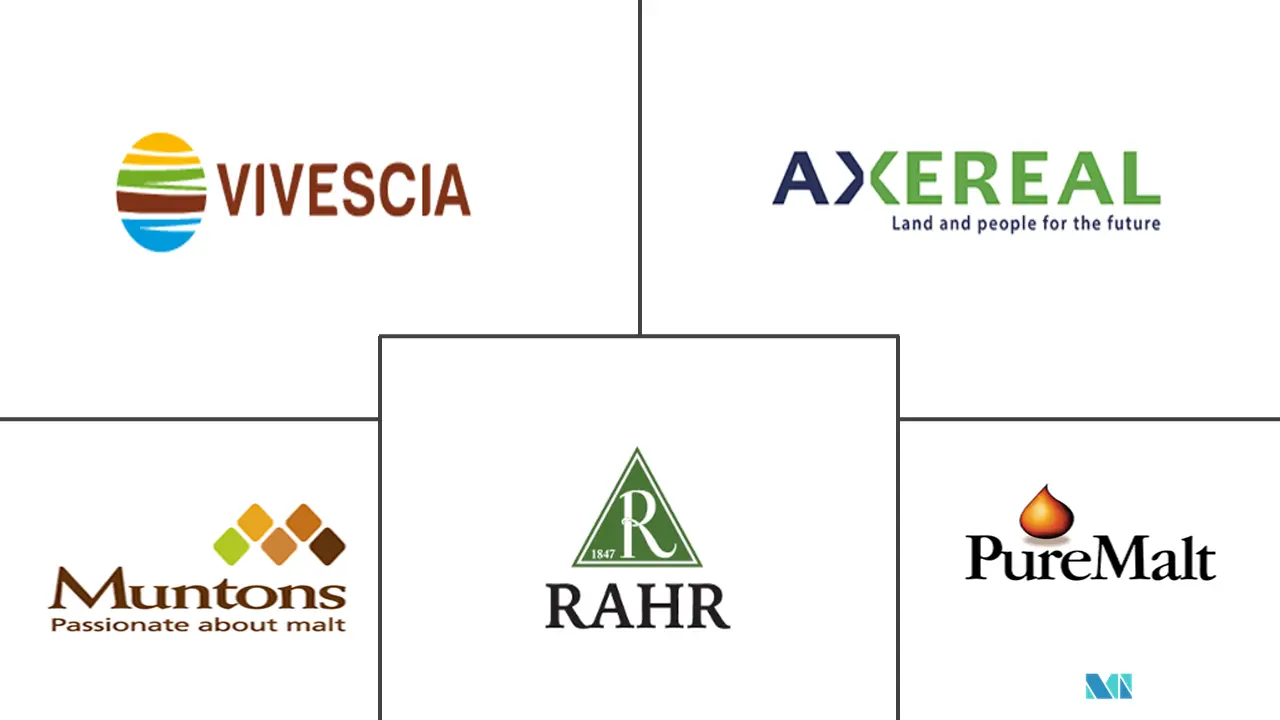Market Size of Asia-Pacific Malt Ingredient Industry

| Study Period | 2019 - 2029 |
| Base Year For Estimation | 2023 |
| Forecast Data Period | 2024 - 2029 |
| Historical Data Period | 2019 - 2022 |
| CAGR | 5.20 % |
| Market Concentration | Low |
Major Players
*Disclaimer: Major Players sorted in no particular order |
Asia Pacific Malt Ingredient Market Analysis
The Asia-Pacific malt ingredient market is expected to record a CAGR of 5.2% during the forecast period.
Malt has been a primary ingredient for applications in the brewing industry for decades. With the growing awareness about its benefits, malt has tapped into the food industry as an additive, flavor, colorant, and ingredient. Moreover, the high consumption of this ingredient in the feed industry is further aiding the market studied. Barley remains the most preferred source of malt for application in the beverage industry, owing to its unique enzyme property and relatively better taste profiles.
Moreover, natural substances are increasingly in demand for usage in a variety of dermatological and cosmetic applications. To fulfill the naturalness of components, these elements frequently act as substitutes for dangerous synthetic raw materials or non-sustainable generated raw materials. To increase bioactivity in cosmetic applications, malt, one of the most significant ingredients in the brewing business, comprises a variety of substances, including phenolic compounds and melanoidins. In addition, malt includes smaller phenolic compounds with strong antioxidant effects, including procyanidins, lignans, alkylphenols, and derivatives of the cinnamic acid.
Furthermore, many baked foods contain malt powder or malt flour, which adds a natural sweetness to the baked products and imparts a brighter and browner result. There are two varieties of malt powder. Diastatic malt contains enzymes that break down starches into sugar and typically produce sweeter, smoother, and higher-rising baked items. Non-diastatic malt is considerably more typical but lacks enzymes. This can nonetheless provide baked items with a desirable flavor and appearance.
Asia Pacific Malt Ingredient Industry Segmentation
Malt is a grain product added to foods and beverages to add flavor and nutrients and serves as a base for fermentation. Malt is prepared from cereal grain by allowing partial germination to modify the grain's natural food substances. Although any cereal grain may be converted to malt, barley is chiefly used. Rye, wheat, rice, and corn are used much less frequently.
The Asia-Pacific malt ingredient market is segmented by source, application, and country. By source, the market is segmented into barley, wheat, and other sources of malt. Others sources include rye, rice, and sorghum. By application, the market is segmented into food, beverages, pharmaceuticals, and animal feed. Beverages are further categorized as alcoholic beverages and non-alcoholic beverages. By country, the market is segmented into China, India, Japan, Australia, and Rest of Asia-Pacific. For each segment, market sizing and forecasts have been done based on values in USD million.
| By Source | |
| Barley | |
| Wheat | |
| Other Sources |
| By Application | ||||
| Food | ||||
| ||||
| Pharmaceuticals | ||||
| Animal Feed |
| By Country | |
| India | |
| China | |
| Japan | |
| Australia | |
| Rest of Asia-Pacific |
Asia-Pacific Malt Ingredient Market Size Summary
The Asia-Pacific malt ingredient market is experiencing a robust growth trajectory, driven by its extensive applications across various industries. Traditionally a staple in the brewing sector, malt has expanded its reach into the food industry, serving as an additive, flavoring agent, and colorant. Its popularity is further bolstered by its significant use in the feed industry. Barley remains the dominant source of malt, particularly in the beverage sector, due to its unique enzymatic properties and favorable taste profile. Additionally, the demand for natural ingredients in dermatological and cosmetic applications is on the rise, with malt's bioactive compounds, such as phenolic compounds and melanoidins, playing a crucial role. The baking industry also benefits from malt, with diastatic and non-diastatic malt powders enhancing the flavor and appearance of baked goods.
The craft brewing and distilling sectors have seen substantial growth, with consumers in the Asia-Pacific region increasingly seeking unique and flavorful beer options. This trend has spurred demand for specialty malts, particularly in the burgeoning microbrewery scene. Leading malt manufacturers are responding by offering a diverse range of malt varieties to cater to these niche markets. The end users of malt extend beyond breweries and distilleries to include the food, pharmaceutical, and pet food industries, among others. In India, the rising consumption of processed foods has significantly boosted malt ingredient sales. However, the country relies on imports to meet its quality malt demands, particularly from Australia. The market is characterized by fragmentation, with numerous global players and private labels competing to provide versatile malt-derived products. Companies are focusing on innovation and market expansion to strengthen their positions, as evidenced by recent strategic developments and partnerships in the region.
Asia-Pacific Malt Ingredient Market Size - Table of Contents
-
1. MARKET DYNAMICS
-
1.1 Market Drivers
-
1.2 Market Restraints
-
1.3 Porter's Five Force Analysis
-
1.3.1 Threat of New Entrants
-
1.3.2 Bargaining Power of Buyers/Consumers
-
1.3.3 Bargaining Power of Suppliers
-
1.3.4 Threat of Substitute Products
-
1.3.5 Intensity of Competitive Rivalry
-
-
-
2. MARKET SEGMENTATION
-
2.1 By Source
-
2.1.1 Barley
-
2.1.2 Wheat
-
2.1.3 Other Sources
-
-
2.2 By Application
-
2.2.1 Food
-
2.2.2 Beverages
-
2.2.2.1 Non-alcoholic Beverages
-
2.2.2.2 Alcoholic Beverages
-
-
2.2.3 Pharmaceuticals
-
2.2.4 Animal Feed
-
-
2.3 By Country
-
2.3.1 India
-
2.3.2 China
-
2.3.3 Japan
-
2.3.4 Australia
-
2.3.5 Rest of Asia-Pacific
-
-
Asia-Pacific Malt Ingredient Market Size FAQs
What is the current Asia-Pacific Malt Ingredient Market size?
The Asia-Pacific Malt Ingredient Market is projected to register a CAGR of 5.20% during the forecast period (2024-2029)
Who are the key players in Asia-Pacific Malt Ingredient Market?
Puremalt Products Ltd., Muntons PLC, Axereal, Rahr Corporation and VIVESCIA Group are the major companies operating in the Asia-Pacific Malt Ingredient Market.

